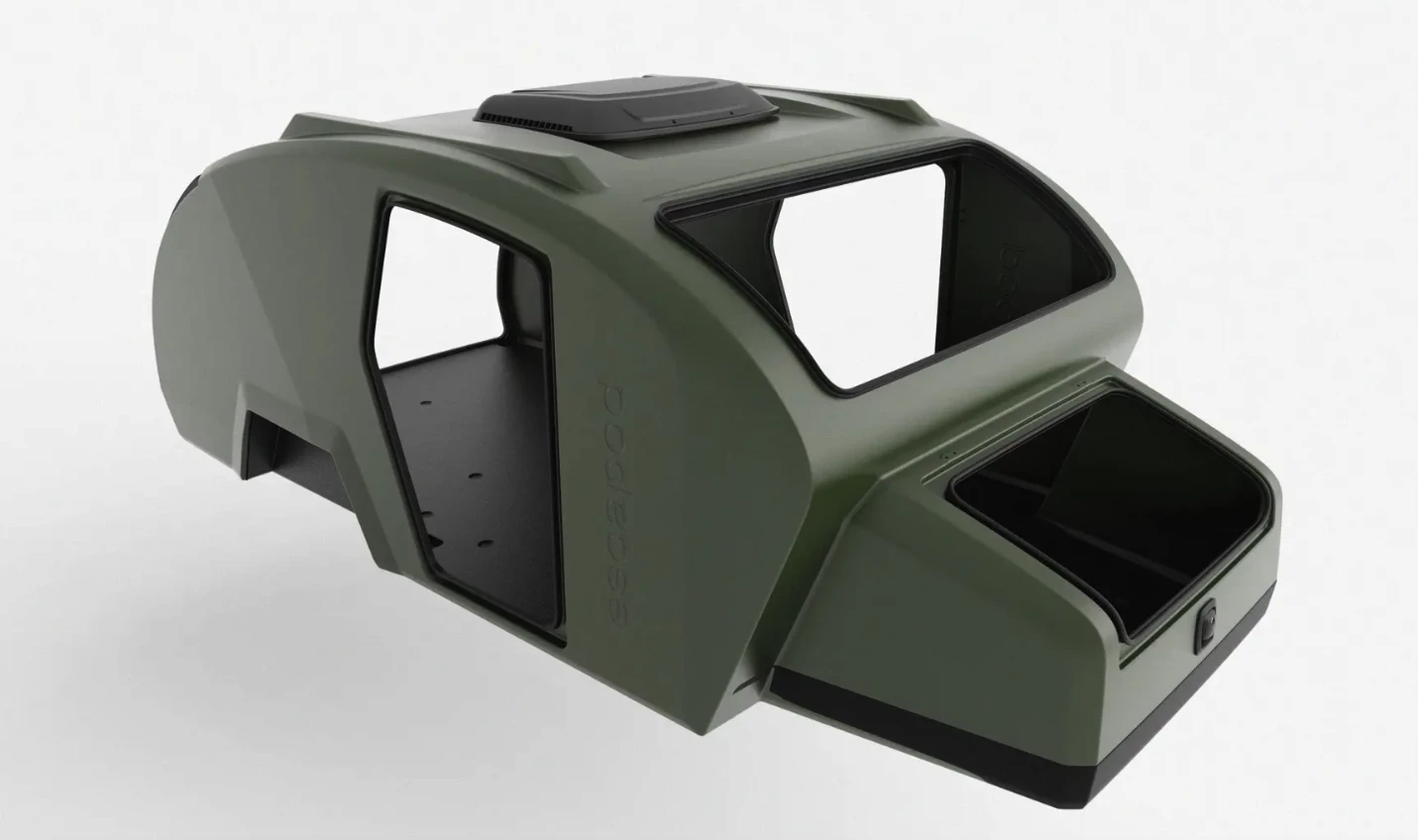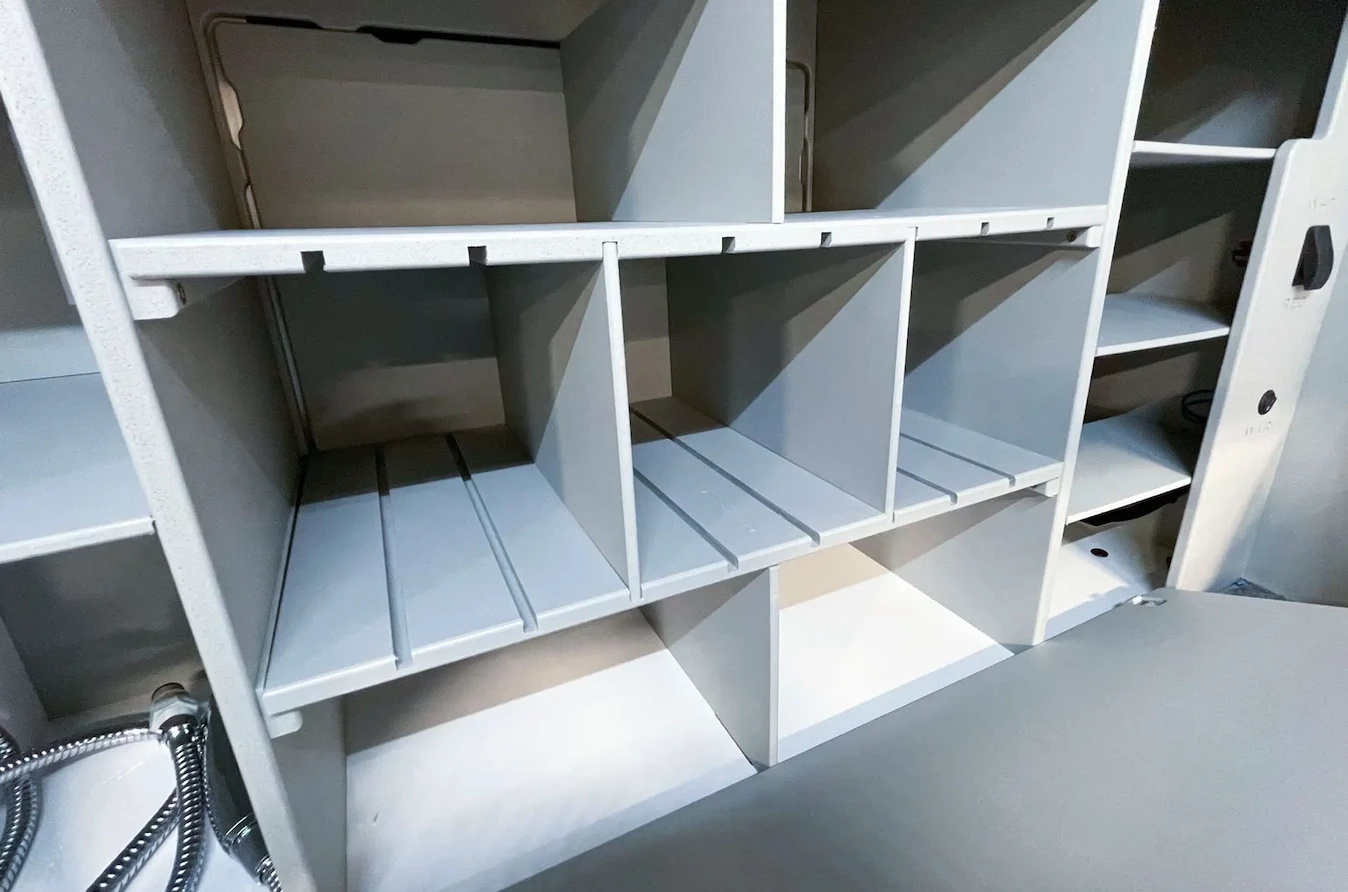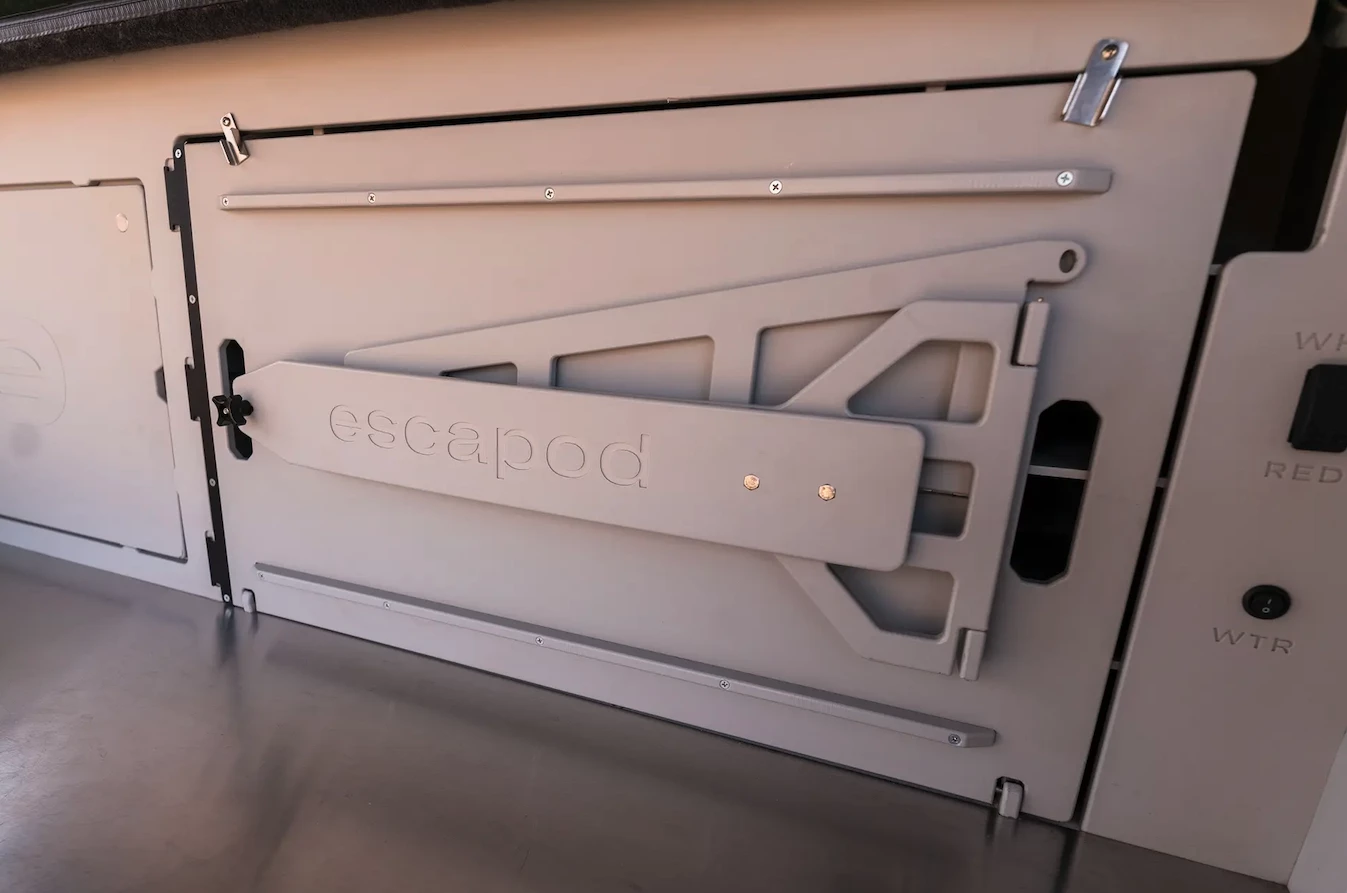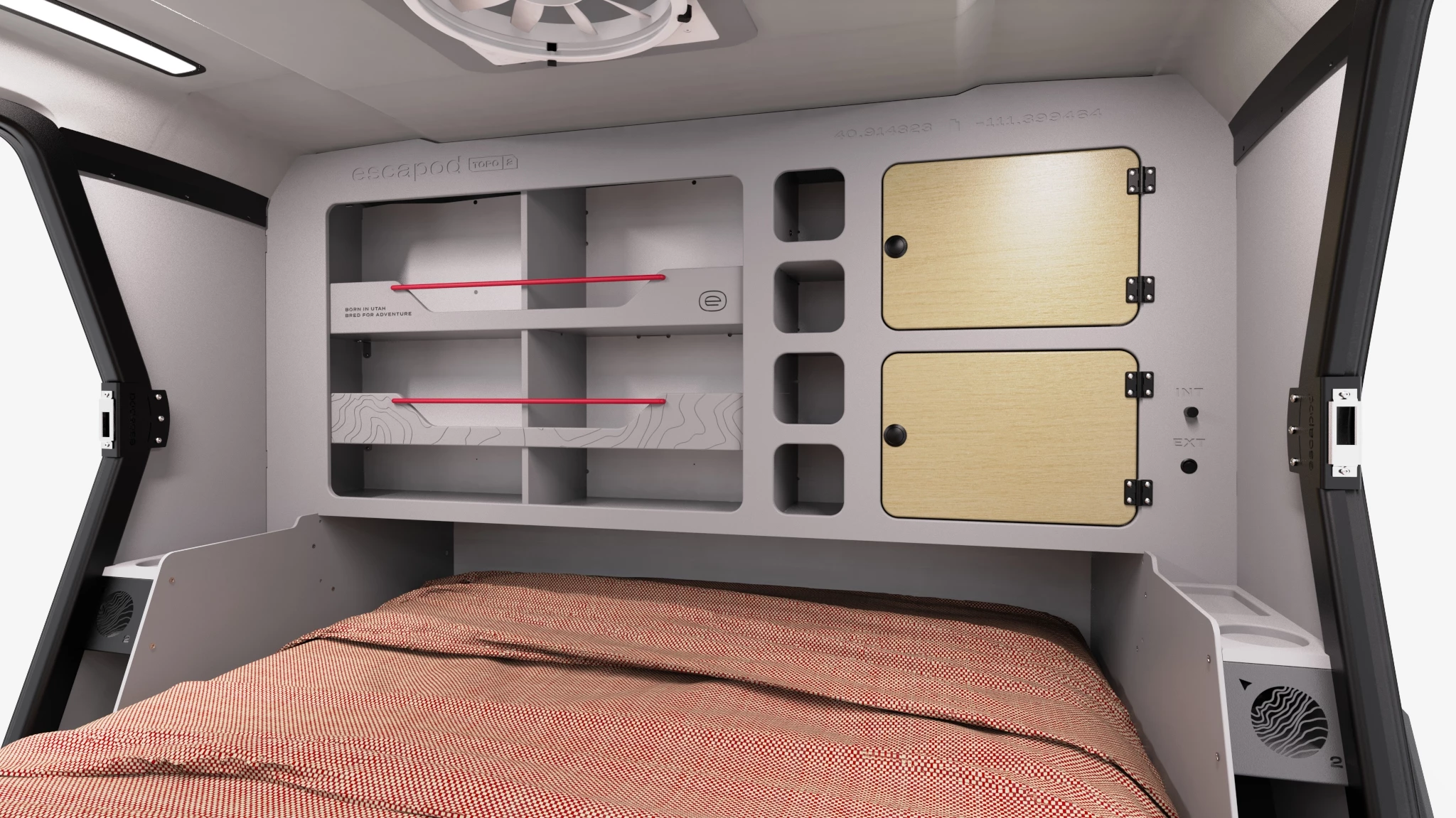Escapod teardrops have come a long since we reviewed the original Topo trailer back in 2019. The early aluminum-on-wood design gave way to a more complex model: the all-composite single-shell Topo2, an even more stylish, colorful take on the iconic teardrop. Does the handsome arched fiberglas-composite pod hold its own on a trip through some of the rawest, most awe-inspiring terrain in the US Lower 48? Only one way to find out.
New house
The Topo2, which launched alongside the original Topo in 2021 and replaced it completely in 2022, hasn't been the only big change at Escapod. The first time we picked up a review trailer, Chris Hudak, who cofounded the company with his wife Jen, was wrenching away by his lonesome in the small garage at HQ, a former gas station. It was the kind of perfectly quaint location you'd expect to find a teardrop startup, but it didn't provide space for the company's rapid growth.
Soon after, Escapod outgrew the gas station-turned-workshop in the 400-strong census-designated place of Wanship, Utah and moved into a 10,000-sq-ft (929-sq-m) former car dealership just down the highway in Coalville, population 1,500. That was in 2020, and it has since expanded that facility into a 22,000-sq ft (2,044-sq-m) space with individual work stations spread around multiple buildings.

Both locations are just a quick drive from Park City and under an hour from Salt Lake City metro, but Hudak and company are committed to keeping their production in the more rural part of Utah's Summit County, an area that sits cozily near the corner of the Wasatch and Uinta mountain ranges, each of which invites teardrop-hitched off-grid explorers to disappear into the wild at a second's notice. Not a bad location choice, we'd say.
This time around, Hudak had time for more than a quick hand-shake, kindly giving us a tour of the facility while Escapod's operation kept humming at the capable hands of a staff of roughly two dozen. New ride
The Topo2's manufacturing process was developed side-by-side with the trailer itself and remains an inextricable part of the product. Escapod starts by welding together its steel chassis in-house before sending it out for an immersive molten zinc galvanization that coats not only the external steel tubes but also their inners through pre-drilled assembly holes, providing comprehensive protection against corrosion.

Hudak told us the company switched to galvanization from the powder-coating process it used previously after finding that galvanization provided better protection once the steel is scratched or damaged. Either way the damaged section becomes susceptible to corrosion, but with powder-coating that corrosion had the tendency to spread, whereas with galvanized steel it stayed within the scratched or damaged area only.
The Topo2's fiberglass-composite body shell, meanwhile, is infusion-molded and insulated with a PET foam core, designed as a four-season construction for year-round camping, even in Utah's notoriously snowy winters. Once ready, the body gets fully fitted out with the kitchen area, cabinetry, electrical equipment, etc, before getting bonded to the floor with ultra-strength adhesive. Finally, finishing touches like interior trim, doors, tongue box and skylight are added.

This construction methodology ensures a structural composite body shell that doesn't require any metal or wood framing behind it. The seamless single-piece body and integrated rain gutter system eliminate any possibility of leaking. New getaway
While the Topo2 absolutely looks state-of-the-art up close, doubly so when seeing its manufacture in action, it ultimately comes down to how it performs. So once Hudak handed over the keys to the lockable trailer doors, we steered the camper northward for a tour into the Sawtooth Mountains.
My family and I had been planning a trip to Stanley, Idaho for years, but what should have been a relatively easygoing five-hour road trip from our home in Northern Utah was repeatedly foiled by wildfires, lack of available accommodations, and, quite frankly, the fast, relentless march of time. A Topo2 teardrop test was the perfect opportunity to make it happen.
Prior to this trip, we had ventured so far north as Ketchum (Sun Valley), a beautiful mountain town in its own right but not quite as remote and ruggedly primitive as the lands just a little farther north. Pictures of the greater Stanley area had prepared us for the beauty, but not the sheer raw remoteness of the topography, a horizon of incisor-sharp peaks backdropping huge patches of evergreen forest interspersed with rippling scrub brush-carpeted meadows. Winding roads diving deep between steep hillsides littered with jagged deadfall and boulder-size talus, towns few and far between. Stanley itself is less the proper town we were expecting and more a tiny roadway intersection with a few businesses scattered about.

We stopped in Ketchum the first night to enjoy some pedaling in one of the country's great bicycle meccas. The Topo2's rear hitch receiver was critical here, carrying three out of four bikes on a simple fold-up rack, with the other riding on a pickup truck bed rail rack. The 250-lb-rated (113-kg) hitch receiver is a simple US$400 option on the Topo2 that would be easy to overlook, but anyone who plans to carry bicycles, kayaks or other large gear on their teardrop trips should definitely consider checking that particular box. Not sure we would have been able to fit all four bikes without it, even with a 5.5-foot pickup bed.
On the road
The original Topo felt virtually non-existent on the hitch when turning and accelerating, and while the Topo2 is slightly larger, it's still quite easy to tow and maneuver, blending quietly into the greater drive. The second-gen trailer weighs roughly 2,100 lb (953 kg) when filled with water, measuring a foot (30 cm) longer than the original Topo at 13.5 feet (4.1 m) and 3.5 inches (9 cm) taller at 6.7 feet (2 m). Its fender-to-fender width checks in at the same 7 feet (2.1 m), but the Topo2 body spans wider, extending farther out over the fenders. The Topo2 has a gross vehicle weight rating of 2,990 lb (1356 kg).
Our tow vehicle was a 2018 Toyota Tundra with 5.7-liter V8, and overall acceleration and handling, on everything from interstate highway with 80-mph (129-km/h) speed limits, to switchbacking mountain passes, to narrow vehicle-width dirt roads, was never an issue. Escapod's light construction and house-developed Freeride independent suspension kept everything smooth behind the bumper. We dialed in the Tundra's tow package braking sensitivity for the trailer's (optional) electric brake system immediately after hitching up and stopped confidently throughout the 800-mile (1,288-km) round trip.
Making camp
We were lucky to find two gorgeous base camps with relative ease, the first tucked up against a conifer-and-scree-dotted slope. The second was on a fairly bald, open ridge minutes outside the main intersection of Stanley, offering sweeping views of the region's superlative peaks.

To the extent you'd call it a setup process, prepping the Topo2 for a stay is about as fast and simple as making camp gets. It's a good idea to drop and crank down the stabilizer jacks to keep everything still and secure, but beyond that, it's really just a matter of flipping open the tailgate if it's time for dinner, deploying the awning if the sun is beating down, or simply popping open the two side doors and heading in to bed.
Because of the rooftop air conditioner sticking up through the Topo2's crossbars, Escapod mounted an iKamper Skycamp rooftop tent (RTT) to our pickup rack instead, providing plenty of space for my family of four to sleep (technically enough space for six people).
The Skycamp, which Escapod offers as a $4,500 option, has a slightly longer setup process than the trailer but isn't at all time-consuming to pitch – pop the latches, pull the ladder out and down to simultaneously unfold the extended floor, lock the ladder into position once it's on the ground and holding the floor extension level, and then pop in a few awning poles. In less than five minutes, it's ready for everyone to bring up their sleeping bags and pillows (if they're not already stored inside).
Calling it a night
My family members took turns sleeping in the Topo2 and Skycamp RTT each night. The warm, cozy confines of the trailer seemed destined to be the clear, unmitigated winner, but there was a caveat: the two sleeping in there would have to squeeze in our 90-lb (40-kg) Greater Swiss Mountain dog, who was not going to make a trip up the ladder or sleep quietly by herself. Apple is a wonderful dog, but she does have some nighttime quirks – diagonal positioning, running in her sleep, and waking up in a pawing and licking frenzy in the middle of the night among the quirkiest.

Fighting off dog paws and tongues or not, the Topo2 still proved the more comfortable option. Not only does the foam-filled composite shell isolate the interior climate, it also insulates effectively against sound, providing a calm, quiet night of sleep. Couple that with a very comfortable 6-in-thick true-queen (80 x 60-in, 203 x 152-cm) memory-foam mattress and large skylight overhead for spotting stars while drifting to sleep, and it's one of the coziest nights one can hope to spend in the great outdoors.
Escapod helps out by transforming cold, industrial fiberglass into an inviting living space. The Topo2 naturally lacks the warming Baltic birch walls of the original, but Escapod has trimmed out the cabin in a combination of soft-touch padding and wood panels and doors, making it every bit as comfortable and homey as its predecessor.

The aforementioned extra body width accommodates both the residential queen mattress and what the company calls mudrooms inside each doorway. These narrow compartments house the HVAC vents and provide space to hang up a jacket, store shoes and sit on the door sill when taking off and putting on footwear.
The interior also includes cabinets in the headboards and over the foot of the bed. The Topo2 carries over the handy feature whereby the center cabinet door folds down to rest on the lower doors and hold a tablet for viewing movies or videos.
Our trip to the mountains benefitted from the warm days and cool nights of summer, so we had no reason to switch on the optional air conditioner or standard cabin heater. We did use the Aqua-Hot two-in-one as a water heater, though, always helpful when scrubbing dishes. The trailer also comes with an outdoor shower sprayer and hookup.

As for the Skycamp RTT, it's a perfectly comfortable place to camp, and the extra breeziness of the fabric walls was a welcome feature for my son and me who both sleep hot. Of course, the thin mattress leaves something to be desired in comparison to the Topo2's memory foam, but a padded level floor always beats the floor of rocks, roots and twigs that await below the thin fabric of a ground tent.
Breaking camp
Camp breakdown for the Topo2 is about as quick and easy as setup, assuming you don't have a lot of cookware, gear or miscellaneous odds and ends strewn about. Kitchen components quickly slide back into place, the side awning folds, rolls and zips away without any drama, and then it's really just closing up the tailgate, doors and tongue box.
The Skycamp is a bit more finicky to put away than to open because the fabric has a tendency to slip out and get caught while you're trying to close and latch the hard top. Still, it's not much more than a five-minute process at worst.
Mealtime
The tailgate galley has been thoroughly reorganized from Topo 1.0 to 2.0. The former had a basic sink setup that paired a bucket with an under-body water sprayer connection, but the Topo2 brings aboard a rather nice inset rectangular sink with faucet. To make room, Escapod has pushed the 8,000-BTU Eno dual-burner stove below the countertop on its own slide-out. The stove is positioned laterally, so you cook behind it and can then keep the fridge slide next to it open for food access or closed when using the extra-long stainless steel counter for prep.

We always liked the extra countertop space that Escapod maintains by not squeezing in both the sink and stove on top, and the new sink is a much cleaner, more readily accessible design that we prefer over the hose and bucket. The stove sits a little lower than optimal, but we like it where it is over integrating it into the counter and losing counter space.
We also like that Escapod doesn't settle for the undersized fridges found in some teardrop galleys, making room for a proper Yeti Tundra 75 cooler or Arb 63 fridge/freezer (each sold optionally). We had the Arb and found it ample for our three-night trip when coupled with a small cooler in the truck.

Escapod does away with fixed compartments in the galley cabinetry to provide the flexibility of adjustable dividers. The door to the adjustable cubbies transforms into a folding side table that attaches to the fender for use as an extra worktop or a dining table. The cabinet door behind the sink, meanwhile, doubles as a cutting board and knife holder – all in all, every little space in the galley has been meticulously planned and executed.
Shortcomings
Truth be told, nothing stood out on the Topo2 as particularly dysfunctional, but there were a few sticking points ... quite literally. Some of the Topo2's hardware was a little beaten up and difficult to open or close. The tailgate had a tendency to stick and was tough to get open and fully closed at times, and the handle to open the tongue box was loose.
Hudak lent us his own Topo2, which had clearly been put through some free-wheeling R&D mileage, so we don't consider any of that to be the result of critical design or construction problems, but it is something to be aware of when purchasing any product built for the abuse an off-road teardrop will take. Things are going to get rattled, smashed and knocked out of alignment so be prepared to fix and tweak small things yourself and/or take the trailer back to the dealer/manufacturer for larger repairs and service. The latter is particularly important to consider if you're purchasing a trailer from a small builder hundreds of miles away.
This isn't a shortcoming so much as a personal preference, but if I were speccing out my own Topo2, I'd skip the air conditioner to make sure I could mount an RTT on the trailer. One of the joys of a camping trailer in general is being able to pop it off the hitch and leave it behind, both to lighten up the vehicle for travel and to keep the campsite reserved and ready for your return.
We did leave the Topo2 when taking a day trip to some incredible waterfall hot springs, and while the Skycamp was easy enough to set up and break down, it would have been ideal to leave it pitched atop the trailer at camp instead of having to break it down and set it back up. That said, there isn't much need for air conditioning in the mountains of Idaho. For hotter, more humid trips, having an air conditioner might be well worth the minor RTT inconvenience. We generally camp in mountains and high desert where A/C is not necessary.
Speccing it out
Price was always the one big disadvantage of stepping up from the Topo1 to Topo2, but focusing on the higher-priced product hasn't seemed to slow Escapod's growth down at all. And since the Topo2's launch in 2021, we've looked at new teardrop-size off-road trailers that start even higher than the Topo2's current US$43,990 base price. Clearly there's a market here, and by dropping the Topo1, Escapod indicated that it found its niche in pursuing a state-of-the-art composite teardrop design.
That base price includes a variety of other equipment not previously mentioned, such as a 120-Ah lithium battery, 140-W solar panel mounted on the tailgate, Thule crossbars, USB and wireless charging ports integrated into small "nightstand" shelves in the cabin, a Simarine systems monitoring screen and a MaxxAir fan. Fresh water is stored in a 76-L tank. From there, Escapod offers options such as the Yeti cooler/Arb fridge, black-out shades, larger and second awning options, upgraded rock protection and rails, a fully articulating hitch and more.

Last year, Escapod split the Topo2 lineup into two models: the fully equipped Voyager model we tested and the Nomad base model. The $33,990 Nomad is a simplified setup built atop the same structure but without many standard features – more of a spec-it-yourself design. The galley, in particular, is much simpler, lacking the inbuilt stove, sink and onboard water storage of the Voyager. Buyers can select from Escapod options like a Dometic Go water system or fill it out with their own gear. It does still include the 120-Ah lithium battery and power system and weighs in at 1,650 lb (748 kg) dry.
While we've always been fascinated with how neatly small trailer designers are able to integrate all the critical features of camping, we've come to appreciate the more flexible approach of the empty base trailer. Not only does it ultimately cut down on that big purchase price, it lets you choose equipment you prefer using (and maybe already have) and provides more flexibility in how you use that equipment.
Onward to 2025
While camping may be the furthest thing from your mind during the holidays, as winter sets in for a long, bitter stay, now is the time to get moving on a new trailer purchase. Escapod's current lead time is three to four months, which would ready a trailer reserved today around the start of North American spring. And if winter happens to stick around a little longer, the heated four-season Topo2 will still be ready to start camping immediately.
Find out more information and spec out your trailer at Escapod.us.



































